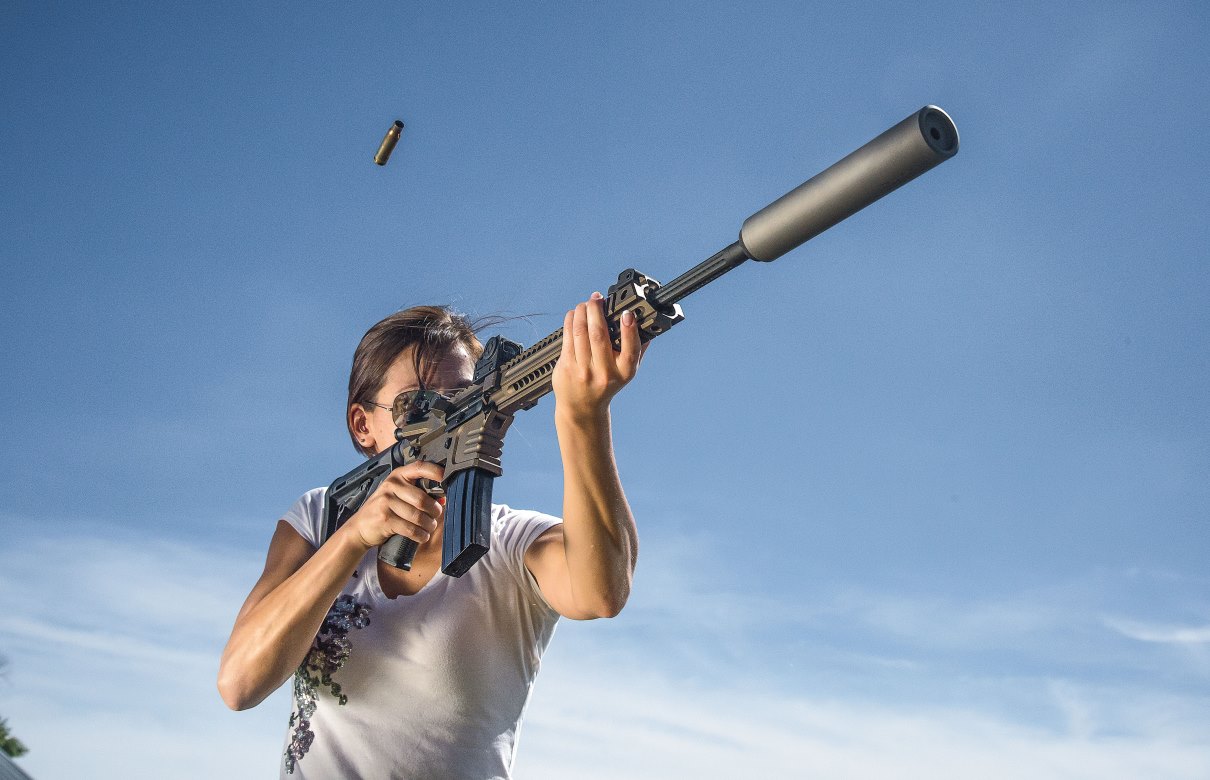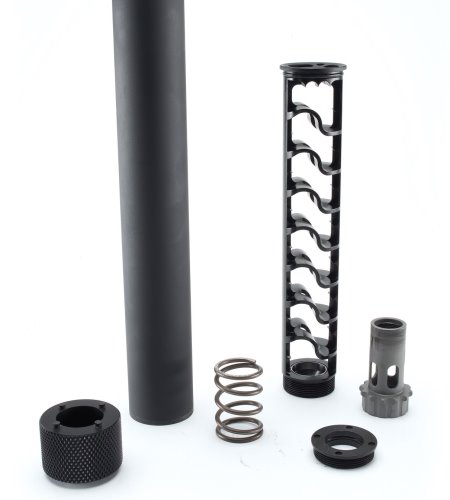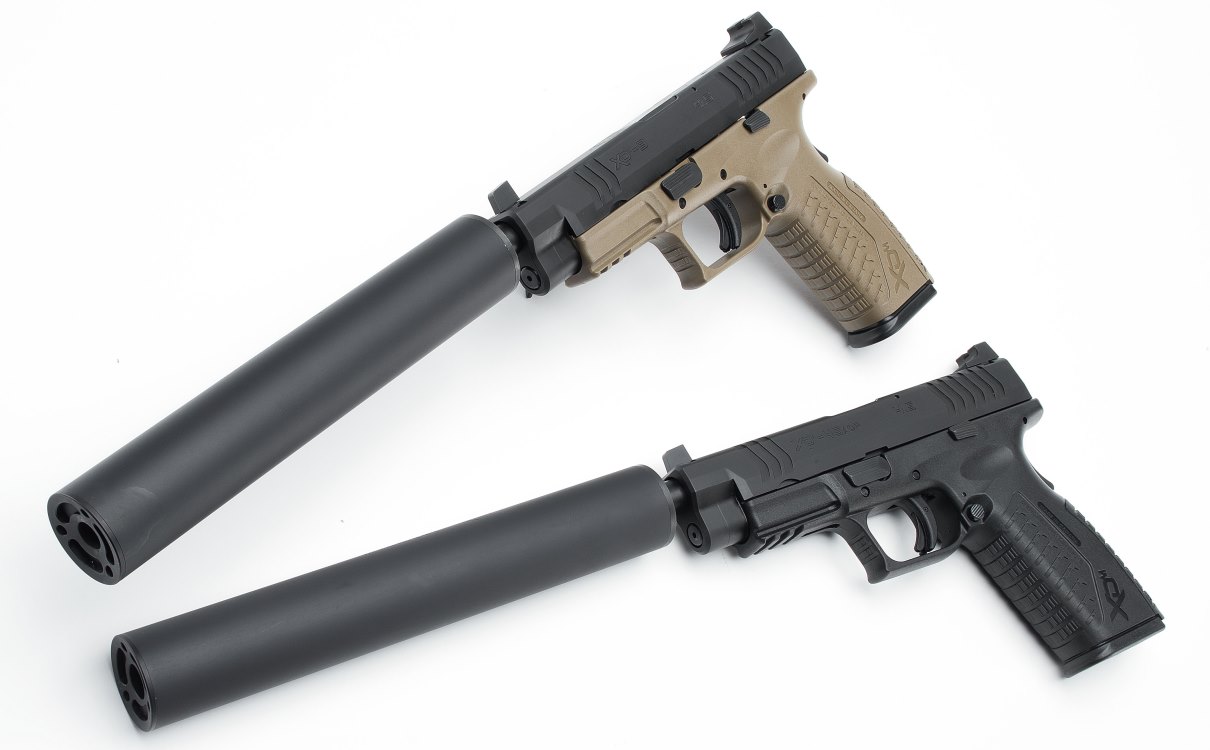Never Satisfied
By: Sean Utley
 Attachment of the YHM's ULT is quick and simple via the Phantom Flash hider. (Photo courtesy of "Shooting Times")
Attachment of the YHM's ULT is quick and simple via the Phantom Flash hider. (Photo courtesy of "Shooting Times")
Yankee Hill Machine continues the quest
There are roughly 40 suppressor manufacturers, and while it may be difficult for any of us to name 10 of them, it’s fair to say that many, if not most shooters, know that Yankee Hill Machine (YHM) produces firearm sound reduction devices.
Starting out as a screw machine house for OEM manufacturers and government defense factories some 20 years ago, YHM enjoyed much success and began manufacturing accessories for the AR-15 in 2000. Handguards and sights were first. In the mid-2000s, YHM expanded to barrels. Six years ago the company began production of complete ARs. Throughout its existence, YHM has continued to adapt, leaving no development stone unturned. From gas blocks, sights, handguards, sling mounts, muzzle devices and on, it’s safe to say that YHM is here to stay.
Suppression
 Sidewinder breaks down to allow the user to maintain or just gawk at its
Sidewinder breaks down to allow the user to maintain or just gawk at its
innards. (Photo courtesy of “Shooting Times”)The move toward suppression came in 2005 with the release of the popular Phantom. Chambered in 5.56, the Phantom was attractive, reasonably priced and allowed budget-minded individuals to make their dreams of owning a suppressor come true. Shortly after the 5.56 version, a .30-caliber version was released in 2006.
YMH Titanium Phantom ULT Specs
Caliber: .30/Multi
Weight: 13 oz.
Overall Length: 7.63 in.
Materials: Titanium and Inconel
Noise reduction: Up to 39 dB
Attachment Type: Quick disconnect ratchet type
Finish: Titanium
MRSP: $1,130
Manufacturer: Yankee Hill Machine
Yankee Hill continues its push in the suppressor market. Two of its R&D engineers are dedicated to suppressor development, and since the initial release of the Phantom, YHM has introduced titanium versions in 5.56, .30 caliber and a large bore version in .338.
In 2014, YHM took the Phantom up a notch by releasing the Titanium Phantom .30 ULT (Ultra-Light Tactical). As the name suggests, the ULT is smaller and lighter than the full-size Phantom .30 cals. YHM claims .308 performance similar to that of the full-size Phantom M2. YHM is clearly focusing on the uber-competitive, multi-caliber can market, boasting improved sound performance in 6.8, 7.62x39, and .300 BLK as compared to its full-size cans.
Built Right
Titanium and Inconel are combined, which means great strength and durability. The ULTs have a “limited” full-auto rating on .300 BLK barrels as short as 8 inches and 10½-inches on other calibers smaller than .308. Tube design has been improved, and a new technique for welds was adopted to help with durability. We compared the Phantom ULT .30 to an older, stainless Phantom LT (light tactical) .30 that we had on hand, and our scales revealed that the ULT shaves 7 ounces from the LT. The ULT weighs 13.6 ounces, an impressive weight for a .30 caliber can. The outer diameter of the Titanium ULT grew to a smidgen under 1.6 inches, up from 1½ inches of the LT, though the factory claims it is still 1½ inch in diameter. The lengths of both are an identical 7.63 inches.
ULTs attach to barrels via YHM’s Phantom flash hider and a tooth and ratchet type system. YHM has left nothing to chance and upgraded the Phantom Q.D. mount system. High temperature springs and carbon scrapers have been added to help remove carbon from the inside where it attaches. New dual support systems help keep the suppressor aligned with the weapon’s bore. The Phantom Q.D. mount comes in 5/8-24, 1/2-28, 1/2-36, and M14x1 LH threading.
We attached the ULT .30 to a Burnt Bronze YHM Specter billet carbine chambered in 6.8 SPC. Sound was decent, and during the photo sessions a couple of our crew opted not to wear hearing protection. The Specter ran fine for a bit, then the sign of too much gas reared its head and malfunctions made us remove the can. We didn’t have one of Gemtech’s suppressor BCG’s with us, and we are sure one of those would have remedied the problem. In defense of the Specter/ULT combo, we must admit we’ve seen this with other rifles chambered in 6.8 SPC, .308 and even .300 BLK. We’ve witnessed pierced and blown primers and bent case rims with different brands of quality ammunition in various guns across the board. Nothing is ever set in stone, so be sure to test, test, test before you buy! Did we mention the Gemtech BCG?
Pistol Suppressors

YHM’s Sidewinder pistol suppressor (Photo courtesy of “Shooting Times”)
YHM’s Sidewinder pistol suppressors debuted earlier this year. Sidewinders come in 9mm, .40 and .45 ACP and are the result of eight years of development. The previous model was the Cobra, and this design is improved in the Sidewinder with a 7075 T6 mono-core baffle design. The outer sleeve is 6016-T6 aircraft quality aluminum. Immediately apparent when you pick one up is how lightweight the Sidewinder is. Technology was not only spared on the baffles and outer tube, the adapter, Nielsen sleeve (booster), blast baffle and rear cap are heat treated 17-4ph stainless steel. YHM uses 17-4ph because it is excellent at resisting wear and corrosion generated from suppressed shooting.
YMH Sidewinder Specs
Caliber: 9mm, .40, 45
Weight: 10 to 10.75 oz.
Overall Length: 7.8 to 8.5 in.
Materials: 7075-T6 aluminum/stainless steel
Noise reduction: 36 dB dry
Attachment Type: Thread on
Finish: Hardcoat anodized matte black
MRSP: $699
Manufacturer: Yankee Hill Machine
User Serviceable
Rifle suppressors are exposed to amazing amounts of heat and pressure and never need cleaning because everything is basically vaporized within the suppressor. Pistol calibers don’t generate near the heat and pressures of rifle calibers, so there is a tendency for lead to build up in pistol suppressors. This is why it’s good to have a user-serviceable suppressor that the operator can take apart and clean any lead build up. It’s also pretty cool to be able to see the inner workings of your suppressor. The mono-core design of the Sidewinder allows easy disassembly for maintenance.
Sidewinders are ready to be attached to your Glock, SIG, HK or other Browning-action-type pistol and run reliably. Some manufacturers make you buy the Nielsen sleeve, or booster, separately. Not YHM. The Sidewinder comes with one.

YHM’s Sidewinders are truly hearing safe when coupled with the appropriate ammunition. (Photo courtesy of “Shooting Times”)
Thanks to a dozen index points on the Nielsen device, the operator can change the point of impact of the Sidewinder. The operator need only grab the suppressor and pull it away from the host pistol and rotate it until it clicks into the next position.
Where the Sidewinder trumps the Cobra is in its sound reduction. YHM put in plenty of work to maximize its mono-core design and achieve hearing-safe levels using standard 230-grain ammo. Unlike the Cobra, the .45 Sidewinder is truly hearing safe. Sound signature is rated at 130.5 dB from a Glock 21 with Armscor 230-grain ammo. The 9mm is rated at 124 dB with 147-grain Winchester ammunition.
We ran the 9mm Sidewinder both wet and dry on a Springfield XD-M with threaded barrel and only experienced one malfunction with the initial wetting of the can. Other than that, it was suppressed fun.
Yankee Hill continues to raise the bar. It’s a great time for suppression … and it’s only getting better.